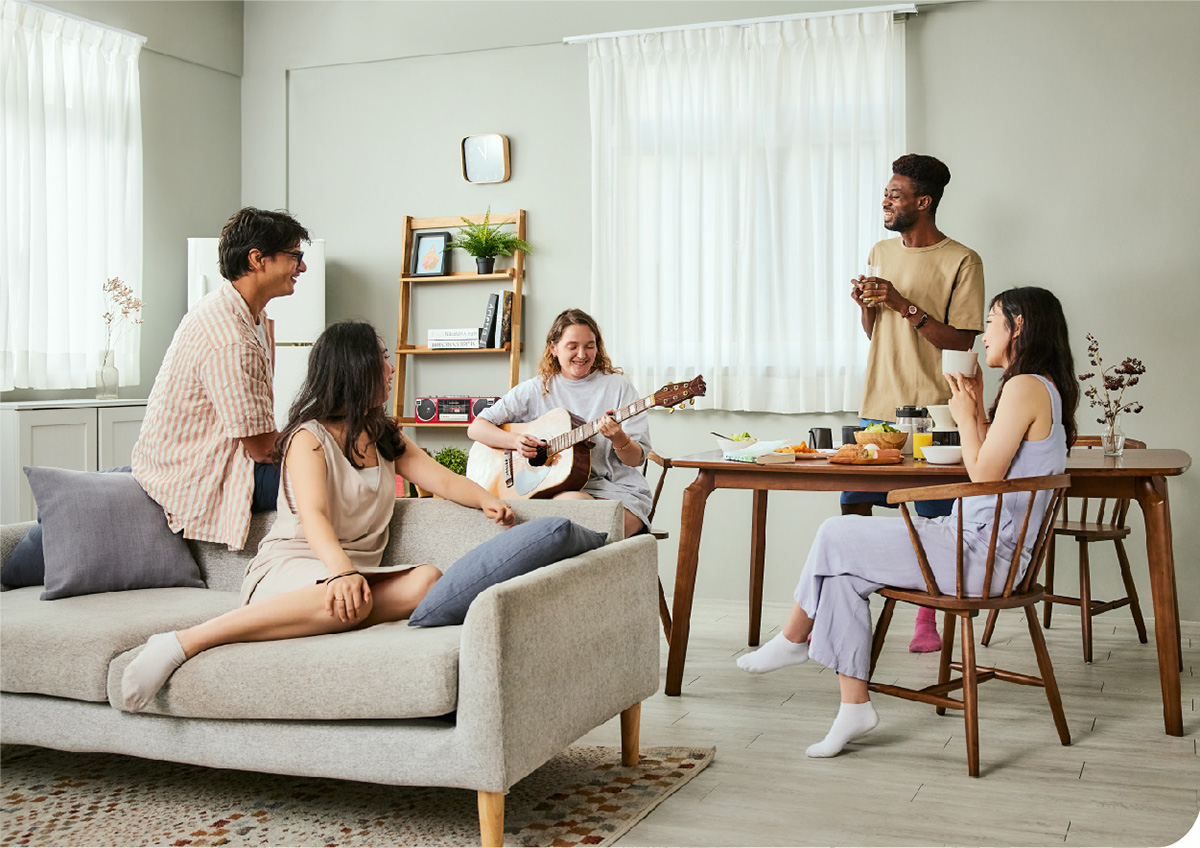
With the continuous growth in single-person households, a new form of residence called a “sharehouse” has been rising in popularity. With the campuses rapidly regaining their former energy, the Sungkyun Times (SKT) would like to introduce the concept of sharehouses for Kingos that may be looking for new homes, as well as its push and pull factors, and some advice for a sensible life.
A Modern and New Style of Living
A “sharehouse” refers to a form of residence where multiple people live in a single home but are given private bedrooms. Residents share common areas, including the living room, bathroom, and kitchen. Demand for sharehouses has been recently rising in Korea with an increase in young single-person households. Sharehouses are often confused with the notion of hasukjip, a traditional Korean boarding house. However, those two are different in that sharehouse residents barely interact with the house owner unlike hasukjip. Generally, sharehouses offer separate bedrooms, but the concept has gradually diversfied with time. For instance, nowadays, there are room-shares in which one shares a bedroom with someone, as well as co-living houses in which tenants share special common areas such as fitness zones and lounges apart from the living room. Sharehouse branches around the Humanities and Social Sciences Campus and Natural Sciences Campus at Sungkyunkwan University (SKKU) include Enough House, Sharehouse Woozoo, and Come&Stay.

The Push and Pulls of Sharehouses
Much Higher Quality of Life
1. A Cost-Effective Choice
One of the main reasons behind the popularity of sharehouses among young people is that it is a cost-effective form of residence. The inferior living environments of young single-person households has long been a social issue in Korea. According to a survey by the Ministry of Land, Infrastructure, and Transport in 2021, single-person households among the youth that do not meet the minimum housing standards is 7.5%, the highest among the surveyed age groups. The continuous rise of ji-ok-go, a Korean abbreviation referring to semi-basements, rooftop homes, and goshiwon (a very small dormitory-style single housing facility) as housing among young people, adds to the seriousness of the problem. As such, many have started to turn to sharehouses for housing. Although the sharehouse’s rent prices may not be significantly lower, the deposit costs are cheaper than other housing options. Moreover, sharehouses are typically fully furnished and equipped and even provide tenants with a much wider space, as the common area is also open for use. Most of all, by living in a sharehouse, one can enjoy all these merits by paying a relatively economical rent compared to other housing choices.
2. Housemates Equals Emotional Support
Besides economic reasons, living in a sharehouse improves one’s quality of life, as residents can experience community sentiment. With the rapid increase in single-person households, the sense of loneliness and isolation individuals experience has become a growing social disease. According to a survey in 2022 regarding one person households in Seoul, the sense of loneliness experienced by residents is 62.1%, while isolation is 13.6%. Sharehouses may be a solution for such mental health issues. Sharing common areas often leads to active social and emotional interactions, and sharehouse owners even offer programs that allow housemates to connect with each other. Furthermore, sharehouses also lower the individual’s anxiety regarding safety problems. Kwon Ji-hyun (Senior, Department of Korean Language and Literature) said, “It has been a few months since I started to live in a sharehouse. So far, it has been reassuring to know that there are people living beyond bedroom doors who can lend me a hand whenever anything happens to me.”

Living with Others Is Not Always Easy
1. Constraints to Freedom
Regardless of these positive functions, a considerable drawback for sharehouses is that they constrain freedom. Residents must be conscious of their housemates even during trivial daily choices, and such minor inconveniences may pile up to become a huge stress factor. Shared facilities, such as bathrooms and kitchens, must be utilized with care, and other little actions, such as doing the laundry and switching the lights on or off, must be executed with caution. Moreover, one must refrain from personal activities such as playing instruments, owning a pet, and eating or bathing during late hours. It is also almost impossible to invite friends over when this is clearly stated in most sharehouse contracts. With all house members having to sacrifice some of their freedoms, an uncooperative attitude may lead to conflicts among housemates.

2. Conflicts with Housemates
Conflicts with housemates are the primary reason for stress while living in a sharehouse. Although most people dream of a healthy interchange with their housemates, collision is inevitable among strangers with different backgrounds. house rules, unlike other communal residences such as dormitories. A lack of such rules leads to uncertainty regarding household responsibilities, especially chores, which often leads to unfair work division amongst the residents. Moreover, there are limits to keeping one’s private belongings without trespassing in the common areas, as no segregated space is provided except for individual bedrooms. This naturally leads to high accessibility to other tenants’ belongings, exposing one to theft or robbery.
Through Thick and Thin
After entering the house, one must aim to coexist peacefully with their housemates for the perfect sharehouse life. First, tenants must keep an open attitude toward conversations, recognize each other’s life patterns, and create shared promises in the form of a contract. An ideal lifestyle would include keeping written rules regarding cleaning duties as well as a particular schedule for, such as running the washing machine. Moreover, residents must constantly communicate with each other in case of rule-breaking or conflicts instead of keeping silent to avoid disputes. Sharehouse operators should also introduce procedures to prevent and solve conflicts regarding daily habits. Son Yea-won, a manager of a sharehouse branch of Enough House, explained, “Enough House receives a contract from tenants regarding internal regulations. Once there is a conflict, we try our best to help avoid an uncomfortable situation before proceeding with a check-out measure.”

Tips for Finding the Right Sharehouse
1) Find the right sharehouse branch.
ㆍCheck if there is a valid lease agreement.
ㆍThen find out if the contract period, monthly expenditure (rent, utility bills, etc.), common facility usage rules, and restricted actions are clearly stated.
→ A vague contract may cause trouble afterward!
2) Check out if the owner responds rapidly and whether the house is regularly checked.
ㆍThis is to minimize emergency situations such as power outages, facility damage, and leaks.
3) Now, all that is left is deciding on the right house and room.
ㆍGo on a housing tour before signing the contract, then check if the house correlates with your priority list.
ㆍFor instance, is the house close to the station? How is the lighting? How is the quality of the shared facilities?
ㆍYou can also speak to the manager about the characteristics of your potential housemates, which may give you a glimpse into your future sharehouse life!

In the age of “singlisation,” finding a space to live has also become difficult. Some may find sharehouses to be an attractive form of living, while others may find them to be uncomfortable nightmares. The SKT hopes that through understanding the pros and cons of sharehouses, Kingos will be able to find the perfect home for the ideal campus life in the coming semesters!
